Selecting Alpine Lakes
When I was young I loved to fish alpine lakes. The scenic perfection of Utah’s High Uinta lakes drew my attention. I learned early that a lake’s remoteness equated into great fishing; consequently, an arduous hike led to an angling treasure.
In the sixties I explored hundreds of back country lakes in search of the perfect Shangri-la. I hoped that my next trek would lead to a paradise with huge trout and outstanding scenery. My Shangri-la was never found, but I did experience some great fly fishing.
Then the seventies came and with it an explosion in outdoor recreation. Backpacking became popular and equipment technology boomed; thus, my once remote lake basins were filled with backpackers. Soon the fishing demised. It even became difficult to find firewood at some of my old favorite lakes. I lost interest in the high lakes and spent my time fishing the valley waters.
Nowadays an emphasis on catch and release has somewhat restored the fisheries. The pristine surroundings and the strikingly beautiful trout make alpine lake fishing a

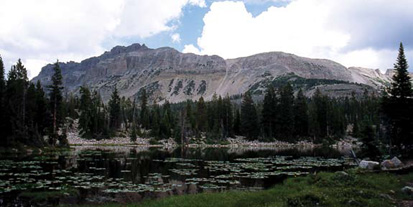
splendid experience although the rules have changed. Remoteness no longer equates to excellent fishing—it is the least visited lakes that afford the best angling.
Search for the overlooked lakes with faint trails leading to them. For example, I found a small isolated lake sitting just a half mile from the major trail. It provided excellent angling.
Alpine lakes are usually glacier-cut depressions found in mountainous cirques; they collect the ground water and the snow melt. Western alpine lakes usually are sited at high altitudes exceeding 9,000 feet. The summer growing season can be a brief one running from July through mid-September. Because of these elevations, winter snows can occur any time in September. This brief season affords marginal time for fish growth, but a lake’s isolation safeguards them for maximum fish growth.
Some alpine lakes are fruitful while others are not. In general, alpine lakes are less fertile than their valley counterparts. Aquatic weed growths are marginal and insect density is sparse. This limited environment is not conducive to abundant fish production; nevertheless, choose the lakes that are seldom used for they provide the best fishing.
Complications from winterkill devastate many alpine lakes. Here a combination of thick ice cover and heavy snow cover shield the available sunlight. Plant growth and photosynthesized oxygen are stopped and decomposing aquatic plants use up the limited oxygen supply. Since the lake is sealed by an ice layer, oxygen from the air is unavailable. Dissolved oxygen levels drop causing the fish to die.
Winterkill occurs most often in lakes which are sheltered from the winter winds. It is these lakes that accumulate the most snowpack. In contrast, the wind swept lakes are scoured from heavy snowfall accumulations. Therefore these lakes
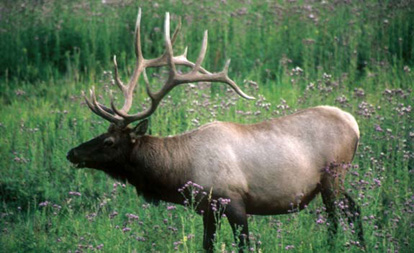
receive more penetrating light. Light is necessary for plants to produce oxygen.
Lakes under the shadow and protection of north slopes receive less wind and more snowpack resulting in a potential winterkill. Likewise, lakes enjoying a southern exposure receive more sunlight and wind. For example, wintering elk herds collect on the high windswept areas where the grasses are uncovered. Adjacent areas receive the same snowfall amounts but the winds distribute the snow unequally. Heavy drifts occur alongside the windswept shallow collections. Avoid the unlucky lakes sited in areas where the deepest snows collect. Some other factors such as the presence of subsurface springs and optimal depths can deter winterkill.
Seasonal snowfall variances affect the lakes subject to winterkill. A mild winter will prevent one.
When scouting alpine lakes, select the ones that are protected from heavy snowdrifts. Choose the southern exposure lakes because they are more likely to receive more sunlight and less snowpack.
Alpine lakes are similar to their valley counterparts in that they share the same structural features, but a primary difference is that alpine lakes usually have lower oxygen levels than lower altitude lakes. This is especially prevalent in the lakes’ deepest hypolimnion zones. During late summer, trout must migrate away from the depths and concentrate in the shallows where oxygen is produced by aquatic plants. In late season avoid the lakes’ depths and fish the shallows.
In addition, fish in high lakes must spend more time foraging for a wide assortment

of foods because the insect hatches can be sporadic and meager. Other aquatic foods such as terrestrials, water boatmen, scuds, and leeches are readily ingested. In fact, alpine fish are not as selective as their valley counterparts.
The wind plays an important role in fishing lakes. The windward shore is found on the lakeside that the wind is blowing from; therefore, terrestrial insects are blown off shoreline perches. Look for fish feeding upon ants, beetles, spruce moths, grasshoppers, houseflies, spiders, and the like. Fish terrestrial fly patterns along these windward shorelines.
On the opposite side of the lake lies the wave-beaten shoreline. Eventually most surface materials will be blown to and collected here as flotsam in drift lines so fish will migrate to feed upon this collection of insects. Additionally, the waves will dislodge aquatic insects from weed beds and rock gardens. These insects become readily available to feeding fish. Casting into surf with nymph patterns can be highly productive. For example, Yellowstone Lake’s surf collects an abundance of feeding fish that can be spotted in the waves. These concentrated fish can be easily reached with a short cast.
I love to visit lakes that I have not yet fished. With thousands of lakes to choose
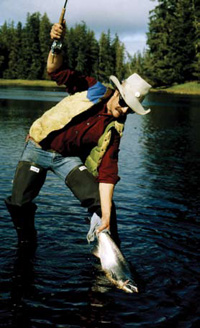
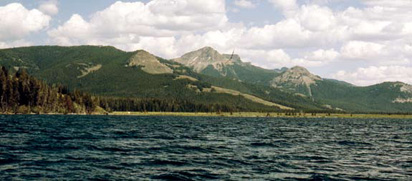
from perhaps my lost Shangri-la still exists.
Fishing pressure is an essential factor in determining productivity. Since these lakes are small and have brief growing seasons, man’s use can greatly influence them. The limited fish population can be decimated by just a few anglers. Always exercise conservation by limiting your take to what you can really use. Look for alpine lake basins with an abundance of wildlife. Areas with large elk herds have limited human usage so you may find excellent fishing. An abundance of shy wildlife is a good indicator of a lake’s fishing potential.
Another method of locating seldom visited lakes is to use a compass to mark on a map a three mile radius scribe line along all access roads and trails. Next, explore the areas outside of the scribe lines. Most human activity occurs within three miles of trails and roads.
Let me share with you a treasure of an alpine lake which is remotely sited in Utah’s Boulder Mountains. This little traveled hike is through both a heavy downfallen forest and a huge lava field. The spring pond sits hidden below a caldera. The area shows no signs of man’s usage but is frequented by a shy cinnamon black bear. The fishing rivals northern Canada with willing brook trout exceeding four pounds. A day spent here is like a journey back into pioneer times.
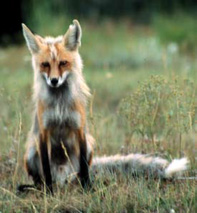

© 2026 The Gale Group, Inc. All rights reserved.
© 2026 Perigee Learning LLC. All rights reserved.
LoveTheOutdoors.com is owned and operated by Advameg, Inc. © 2026 Advameg, Inc.
Camping Adventures • Dutch Oven Cooking • Sports Knots
Fly Tying • Freshwater Fishing • Fly Fishing

